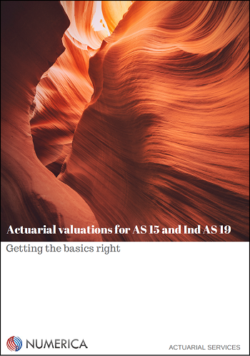
The adoption and implementation of IFRS in the Kingdom of Saudi Arabia (KSA) is a major step towards increasing the transparency and comparability of the financial statements of the companies doing business in the Kingdom. We receive a lot of queries from such companies regarding the impact of this change and the need for actuarial valuation of liabilities. In this post, we aim to provide our perspective on the implementation of IAS 19, especially in relation to it’s application to End of Service benefit plans in KSA.
The various employee benefit schemes prevalent in the KSA are End of Service Benefits (ESB), Annual Leave Encashment and Long Service Awards of which, ESB is the most popular defined benefit scheme and topic of this paper.
What is End of Service Benefit plan?
The Saudi Labour Law entitle a workman of a severance award upon expiration of the employment contract. Such award falls under the long-term employee-benefits category and is known as End of Service Benefit (ESB).
It is to be calculated at half a monthly rate for each of the five first years and one month pay for each of the following years based on the last basic pay. The workman shall be entitled to an award for the portions of the year in proportion to the time spent on the work.
The full ESB award is calculated as per the table below.
Full End of Service Benefit award:
| If years of service <=5 | 1/2 x Monthly salary x Service |
| If years of service > 5 | As above for the first 5 years + 1 x Monthly salary x (Service – 5) |
An employee will receive the full ESB award, as per the table above, if service is terminated by the employer.
However, if an employee resigns, they will receive only a part of the full award. This is explained below.
In case of resignation:
| Years of service | % of full ESB award |
| <2 years | Nil |
| 2 to 5 years | 1/3rd of full ESB award |
| 5 to 10 years | 2/3rd of full ESB award |
| >10 years | Full ESB award |
To calculate the ESB entitlement, please click here.
What is IAS 19?
IAS 19 (International Accounting Standard No 19) a part of IFRS framework that prescribes the accounting treatment of employee benefits. IAS 19 requires entities to perform actuarial valuation to determine the present value of its obligations in respect of End of Service benefit and other employee benefits. It also requires to recognise an expense in respect of employee benefit schemes.
An important concept in IAS 19 is to recognise the cost of providing employee benefit in the period when it is earned by the employee, rather than when it is paid or becomes payable. An actuarial valuation needs to be carried out using a Projected Unit Credit (PUC) method using an agreed set of financial and demographic assumptions that are based on the actuary’s best estimates.
Key highlights of IAS 19
The adoption of IFRS is an era of change in the accounting practices followed in KSA. With respect to IAS 19, the key highlights are:
- The financial statements now have to be prepared on a going concern basis. As such, for the purpose of calculating the defined benefit obligation it has to be assumed that the employees will continue to work beyond the balance sheet date subject to annual attrition.
- Financial and demographic assumptions will now play a major role for valuation. Here are few posts which provide more background on actuarial assumptions:
- The liability will now be calculated based on projected salary at potential exit dates rather than current salary as at balance sheet date.
- Remeasurements have to be presented in the Other Comprehensive Income (OCI)
How often do I need to get an actuarial valuation done?
Actuarial valuations are required at the end of every accounting period for the purpose of preparation of financial statements.
Disclosure requirements
Actuarial valuation and reporting of End of Service Benefits is more than just calculating the present value of the defined benefit obligation. Instead, it requires a more detailed analysis of the liability and the key drivers behind it. In this regard the disclosure requirements under IAS 19 include:
- duration of the liability
- expected future cash flows (year on year)
- sensitivity analysis of the liability with respect to changes in assumptions
- clear bifurcation of expenses (in P&L) and remeasurements (in OCI)
Full disclosures can be found on the IASB website.
Conclusion
- Companies in KSA now need to prepare their financial statements as per IFRS.
- An actuarial valuation of employee benefit schemes is required under IAS 19 to calculate the defined benefit obligation, and produce the required disclosures.
Download our guide on the basics of actuarial valuation by clicking on the picture below:

